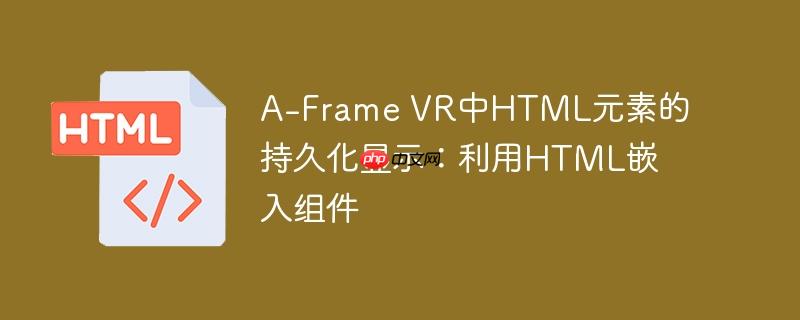
当开发者使用a-frame构建vr体验时,常常需要集成传统的html用户界面元素,例如按钮、文本输入框或信息面板。然而,a-frame进入vr模式后,浏览器默认的html dom元素通常会被隐藏或脱离3d渲染上下文,导致这些ui元素在vr环境中无法显示或交互,从而影响用户体验,尤其是在需要提供“退出vr”或“菜单”等关键功能时。这种现象在ios设备上可能表现出一些差异,但普遍而言,原生html元素在vr模式下的不可见性是一个普遍问题。
为了解决这一问题,我们可以借助第三方A-Frame组件——aframe-htmlembed-component。这个组件能够将标准的HTML和CSS内容渲染成一个3D纹理,并将其作为A-Frame实体(a-entity)的一部分呈现在VR场景中。这意味着你可以像操作其他3D对象一样定位、旋转和缩放你的HTML UI,并且它在VR模式下依然可见和可交互。
该组件的核心优势在于:
要将HTML元素嵌入到A-Frame VR场景中,请遵循以下步骤:
在你的HTML文件的<head>部分,需要引入A-Frame核心库以及aframe-look-at-component和aframe-htmlembed-component。
立即学习“前端免费学习笔记(深入)”;
<script src="https://aframe.io/releases/1.3.0/aframe.min.js"></script> <script src="https://unpkg.com/aframe-look-at-component@0.8.0/dist/aframe-look-at-component.min.js"></script> <script src="https://supereggbert.github.io/aframe-htmlembed-component/dist/build.js"></script>
在<a-scene>内部,创建一个a-entity,并为其添加htmlembed组件。你可以在这个a-entity的内部放置任何HTML内容。
<a-entity position="0 1.6 -1" htmlembed look-at="[camera]">
<button id="exitButton" onclick="console.log('Exit button clicked!'); alert('Exiting VR experience...');">退出VR</button>
<!-- 可以在这里放置更多HTML元素,如<div>, <p>, <img> 等 -->
</a-entity>以下是一个完整的A-Frame场景示例,展示了如何嵌入一个“退出VR”按钮,并使其始终固定在用户视野中:
<!DOCTYPE html>
<html>
<head>
<title>A-Frame HTML嵌入示例</title>
<script src="https://aframe.io/releases/1.3.0/aframe.min.js"></script>
<script src="https://unpkg.com/aframe-look-at-component@0.8.0/dist/aframe-look-at-component.min.js"></script>
<script src="https://supereggbert.github.io/aframe-htmlembed-component/dist/build.js"></script>
<style>
/* 可以为嵌入的HTML元素添加CSS样式 */
#exitButton {
padding: 10px 20px;
background-color: #f44336;
color: white;
border: none;
border-radius: 5px;
font-size: 1.2em;
cursor: pointer;
box-shadow: 0 4px 8px rgba(0, 0, 0, 0.2);
transition: background-color 0.3s ease;
}
#exitButton:hover {
background-color: #d32f2f;
}
</style>
</head>
<body>
<a-scene>
<!-- 场景中的一些基本几何体 -->
<a-box position="-1 0.5 -3" rotation="0 45 0" color="#4CC3D9"></a-box>
<a-sphere position="0 1.25 -5" radius="1.25" color="#EF2D5E"></a-sphere>
<a-cylinder position="1 0.75 -3" radius="0.5" height="1.5" color="#FFC65D"></a-cylinder>
<a-plane position="0 0 -4" rotation="-90 0 0" width="4" height="4" color="#7BC8A4"></a-plane>
<a-sky color="#ECECEC"></a-sky>
<!-- 嵌入的HTML UI元素 -->
<a-entity position="0 1.6 -1" htmlembed look-at="[camera]">
<button id="exitButton" onclick="console.log('Exit button clicked!'); alert('Exiting VR experience...');">退出VR</button>
</a-entity>
<!-- 用户摄像机设置 -->
<a-entity position="0 0 0" wasd-controls>
<a-entity camera position="0 2 0" look-controls cursor="rayOrigin: mouse"></a-entity>
</a-entity>
</a-scene>
</body>
</html>在上述代码中,一个带有“退出VR”文本的按钮被嵌入到3D场景中。由于look-at="[camera]"属性,无论用户如何移动或转动,这个按钮都会保持在视野中。点击该按钮将触发JavaScript的onclick事件,你可以根据实际需求在此处实现退出VR模式或打开菜单等功能。
aframe-htmlembed-component为A-Frame开发者提供了一个强大的工具,解决了在VR模式下集成传统HTML UI的难题。通过将HTML内容无缝嵌入到3D场景中,并结合look-at等组件实现HUD效果,开发者可以轻松创建功能完善、交互性强的VR用户界面,极大地提升了A-Frame应用的可用性和用户体验。掌握这一技术,将使你的A-Frame VR项目能够更好地融合Web的灵活性与VR的沉浸感。
以上就是A-Frame VR中HTML元素的持久化显示:利用HTML嵌入组件的详细内容,更多请关注php中文网其它相关文章!

HTML怎么学习?HTML怎么入门?HTML在哪学?HTML怎么学才快?不用担心,这里为大家提供了HTML速学教程(入门课程),有需要的小伙伴保存下载就能学习啦!

Copyright 2014-2025 https://www.php.cn/ All Rights Reserved | php.cn | 湘ICP备2023035733号